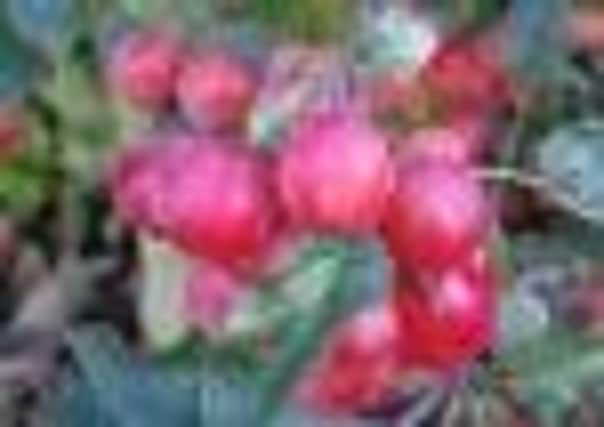Last tips for the autumn bounty


With the weather turning colder, I’ve been using up the last of the courgettes, carrots, tomatoes, borlotti beans, beetroot, spinach and salad from the garden before they get ruined by frost. I’ve left my leeks in the ground as they’ll be fine to harvest over the coming weeks when there’s not much else out there.
Hearty soups and stews that are just perfect for these chillier autumn days. They’re also handy to freeze for use throughout the winter months when you need your vegetable fix.
Advertisement
Hide AdAdvertisement
Hide AdChutneys are also a great way of using up vegetables and fruit, and the flavour combinations are endless. The basic ingredients are the chopped vegetables and fruit of your choice (4kg), sugar (400g) and malt vinegar (up to a litre, depending on the water content of the fruit and vegetables you’re using). You should also add a generous pinch of salt and the spices of your choice, which could be anything from cinnamon and ginger to mace and nutmeg. I add onions to all of my chutneys, but, other than that, I like using apples, pears, tomatoes, courgettes, sultanas, garlic and chilli (although not all at the same time!). Simply place all of your ingredients in a large (non-copper) saucepan and simmer slowly until the fruit and vegetables have softened. Then pour the mixture into sterilised jars.
I had great success with my Butternut Squash plants for the first time this year.
They are perfect for adding to stews and risottos, or for making a really warming soup. Take a look at my favourite soup recipe:
Spicy Butternut Squash Soup
Cut the flesh from one large Butternut Squash into chunks.
Chop one carrot, one onion and two sticks of celery.
Soften all of these ingredients in a large saucepan with a knob of butter.
Advertisement
Hide AdAdvertisement
Hide AdAdd a measuring jug full of vegetable or chicken stock – I’m never too precise as I add more liquid later if the soup’s consistency is too thick.
Add a teaspoon of dried chilli flakes or a generous pinch of chilli powder.
Add two or three sage leaves.
Leave it to simmer until the vegetables are nice and soft.
Take the pan off the heat and blitz the mixture with a hand-held blender.
Return the pan to the heat and add salt and pepper to taste, and a little more chilli if you want a real spice hit.
Add a good glug of cream or crème fraiche before serving.
Recipes for success
Crab Apple Jelly
Advertisement
Hide AdAdvertisement
Hide AdThe little Crab Apple Tree in my garden (part of the Malus family) is laden with ruby-red fruit again this year and it would be a crime not to put it to good use. This jelly is divine smothered over warm scones!
Wash 2kg of crab apples, removing the stalks and any bruised bits. Put them in a large saucepan and just cover with water (don’t fill the pan to the top). Leave to simmer until the fruit is soft.
Remove from the heat and strain the mixture through several layers of muslin. Leave it overnight with a bowl underneath to catch the juice that drips through.
The next day, return the juice to a saucepan, along with 500g sugar and the juice of one lemon.
Advertisement
Hide AdAdvertisement
Hide AdBring to the boil and then keep it at a rolling boil for 30-45 minutes, regularly skimming off any froth that gathers on top.
When the mixture starts to thicken, you can test if it’s ready by dipping in a chilled spoon. If the mixture sets on the back of the spoon, remove it from the heat and pour it into sterilised jars.
Sterilise your jam jars and lids in a hot oven, by putting them through the dishwasher on a hot wash or filling them with boiling water.
When you pour in your jelly mixture, it’s important to fill the jars right to the top to avoid leaving space for any bacteria to form.
Sloe Gin and Sloe Jelly
Advertisement
Hide AdAdvertisement
Hide AdThe harsh winter resulted in another great crop of sloes. These are the dark blue-black fruits of the black thorn bush, found in hedgerows all over the Yorkshire countryside. Sloe Gin can be used to make a luscious jelly – of the dessert variety, rather than the preserve. All you need to do is mix a generous measure of Sloe Gin with lemonade and add gelatine. To get the appropriate ratio of gelatine to liquid, follow the instructions on the pack. My Sloe Gin recipe really could not be easier. Firstly, you have to wash your sloes, remove any stalks and then prick each one to help release the flavour. Fill an empty bottle up to the half way mark with sloes, add a couple of tablespoons of caster sugar and top up with a cheap gin from your supermarket. Pop the lid on and leave the bottle in a warm, dry place, such as an airing cupboard, for a minimum of three months, stirring occasionally. You can add more sugar to taste if it’s not sweet enough, but I don’t like my sloe gin too syrupy – it can end up like cough mixture. By the time it’s ready, the berries will have turned the gin a gorgeous pink colour. All you need to do then is strain the liquid through muslin to get rid of the berries and decant it into smaller bottles.